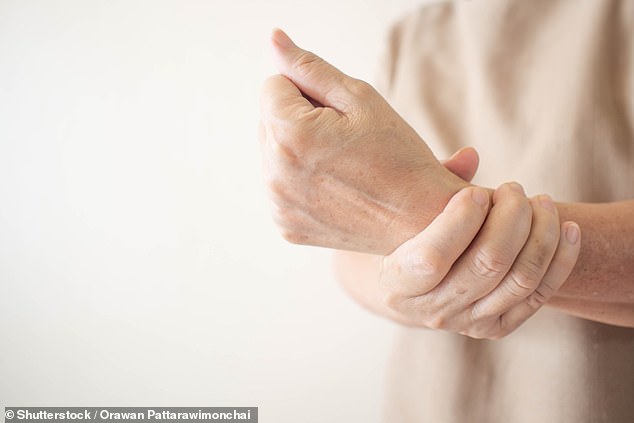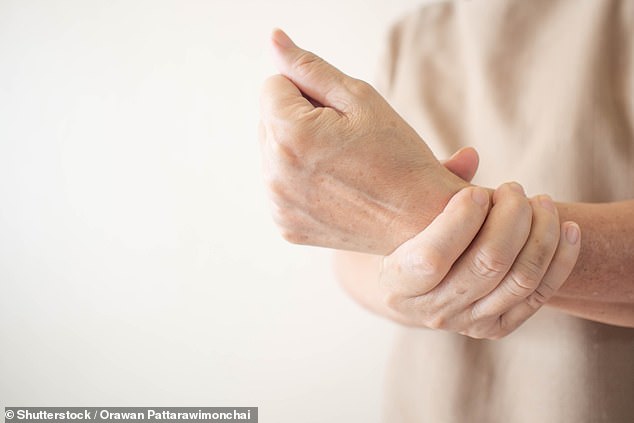The carpal tunnel wrist can now be fixed with a 15-minute procedure, allowing patients to return to work the next day



Sufferers of a common and painful wrist condition that takes years to heal could receive a groundbreaking new procedure that eradicates the pain in minutes.
More than 340,000 people in Britain suffer from carpal tunnel syndrome (CTS) – an uncomfortable hand injury that occurs when a ligament above the narrow passage in the wrist known as the carpal tunnel swells and compresses the main nerve.
The condition can cause debilitating symptoms, including pain, tingling, weakness, difficulty gripping, and numbness.
Previously, the only way to cure severe cases was months of steroid injections and, if that failed, surgery to open the wrist and release the ligament to relieve pressure on the nerve.
Now doctors in Scotland have become the first in Britain to perform a new procedure that takes just 15 minutes, involves no incision and can put patients back to work the next day.

More than 340,000 people in Britain suffer from carpal tunnel syndrome (CTS), an uncomfortable wrist condition (file photo)
The technique, ultrasound-guided carpal tunnel surgery, is widely used in Europe and experts say it is likely to be rolled out across the NHS within the next two years. ‘Patients benefit from reduced pain levels and recover faster than those who undergo conventional surgery,’ says Dr Sally-Anne Phillips, consultant hand and wrist surgeon at private healthcare facility La Belle Forme in Glasgow.
‘We believe this could be adopted as standard practice within the NHS given its efficiency, both in terms of time and cost.’
CTS is often caused by repetitive hand movements, prolonged extension or flexion of the wrist, or conditions that cause joint inflammation, such as rheumatoid arthritis. Certain factors increase the risk of CTS, including pregnancy, obesity, diabetes, a history of wrist injuries, and jobs that require repetitive wrist movements or firm gripping.
The number of cases has also increased due to excessive use of laptops and mobile phones. Symptoms can be severe enough to cause patients to lose sleep and interfere with work and even the most basic daily tasks. In extreme cases, the muscles in the hand and wrist can even atrophy from underuse and, without treatment, CTS can result in irreversible nerve damage and loss of hand function.
Currently, the surgery offered by the NHS involves an invasive operation to open the wrist to cut the carpel tunnel ligament.
Cutting the ligament does not affect the mobility of the hand. Patients rarely experience pain and have full use of their hand while it heals. Research shows that in most cases, CTS does not return, even after the ligament has completely regrown. However, because the procedure involves cutting through layers of fat and muscle to get to the ligament, patients are left with a deep skin wound that can take months to heal.
But the new operation is guided by an ultrasound scan held over the wrist. This allows the surgeon to look into the wrist and does not have to open it.
An incision is made at the base of the wrist and a small needle is passed down to reach the carpal tunnel ligament at the point where it presses on the nerve. The needle is then used to cut the ligament, release the nerve, and then remove it. The ultrasound ensures that the surgeon does not accidentally damage surrounding nerves and blood vessels.
The procedure is performed under local anesthesia and patients can leave the clinic the same day.

The number of cases of the condition has also increased due to the excessive use of mobile phones and laptops (file photo)
The only sign of the operation is some bruising and a small scar, which experts say usually disappears.
Catherine Nolan, 44, discovered the new treatment after exhausting all other options. The Edinburgh-based painter and decorator first noticed pain in both her wrists 18 months ago.
She was diagnosed with CTS and given a splint to support her wrist. But the pain worsened, leaving her struggling with simple tasks such as removing the cap from a bottle. She was given steroid injections, but these provided only temporary relief.
‘It got so bad that I had to take two months off work. I felt like I was losing control of my hands,” she says.
Catherine read about the ultrasound-guided procedure – and signed up for the surgery. It was performed on both her hands.
“There was no discomfort whatsoever and it lasted about an hour and a half,” she says. ‘The next day I took off the bandage and was able to do basic things, such as making a cup of tea.
‘Two days later I went back to work with a little discomfort, but nothing that felt worse than a bruise. Within a week or two I felt better and things have been smooth since.
‘This surgery has been completely life-changing.’




